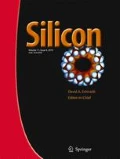Abstract
The presence of large quantities of agricultural waste directed our attention to how to benefit from them. The main concern of this article deals with the extraction of silica from rice husk and Peanut Peel. The material burning in large quantities can produce an environmental problem. Consequently, there is a need to waste disposal. In this study, all waste materials are subject to humidity removal at 200 °C then heat-treated at 900 °C for 7 h. The obtained powders were examined and described by FT-IR and XRD analysis. The Powder obtained from rice husk and Peanut Peel sources found to be SiO2 in Cristobalite and Tridymite phases. The crystal rice husk and Peanut Peel used as an alternative source of silica for the installation of glass samples. Glass samples prepared containing 40% substances produced, in addition to sodium and lithium oxide. The resulting glass studied and tested using a variety of analytical techniques, including x-ray diffraction (XRD), infrared spectroscopy for Fourier transform (FT-IR), differential thermal analyzes (DTA), UV / VIS / NIR spectroscopy. The thermal parameters from DTA data indicate the glass prepared from rice ash have more similarity of glass formed from chemical composition than the glass formed from the Peanut Peel. FTIR show that these glasses consist mainly of SiO4 vibration groups in addition to non-bridging oxygen units. From measurements and studies the visible UV, the optical band gap and intensity of absorption coefficient increase with SiO2 yield from rice husk.
Similar content being viewed by others
References
Lee CS, Matoria KA, Ab Aziz SH, Kamari HM, Ismail I, Zaid MHM (2017) Influence of zinc oxide on the physical, structural and optical band gap of zinc silicate glass system from waste rice husk ash. Optik 136:129–135
Shen Y, Zhao P, Shao Q (2014) Porous silica and carbon derived materials from rice husk pyrolysis char. Microporous Mesoporous Mater 188:46–76
Chindaprasirt P, Jaturapitakkul C, Rattanasak U (2009) Influence of fineness of rice husk ash and additives on the properties of lightweight aggregate. Fuel 88:158–162
Lakshmi UR, Srivastava VC, Mall ID, Lataye DH (2009) Rice husk ash as an effective adsorbent: Evaluation of adsorptive characteristics for Indigo Carmine dye. J Environ Manag 90:710–720
Srivastava VC, Mall ID, Mishra IM (2008) Removal of cadmium(II) and zinc(II) metal ions from binary aqueous solution by rice husk ash. Colloids Surf A Physicochem Eng Asp 312:172–184
Kumar A, Mohanta K, Kumar D, Parkash O, (2012) International Journal of Emerging Technology and Advanced Engineering 2 : 86–90
Mustafa IS, Razali NN, Ibrahim A, Yahaya NZ, Kamari HM (2015). Jurnal Intelek 9:1–6
Hassan AF, Abdelghny AM, Elhadidy H, Youssef AM (2014) Synthesis and characterization of high surface area nanosilica from rice husk ash by surfactant-free sol–gel method. J Sol-Gel Sci Technol 69:465–472
Vaibhav V, Lakshmi U V, Roopan S M, (2015) Spectro chimica Acta PartA: Molecular and Biomolecular Spectroscopy 139 : 515–520
Sharma G, Arya SK, Singh K (2018) Optical and thermal properties of glasses and glass-ceramics derived from agricultural wastes. Ceram Int 44:947–952
Abed Al-Nidawi A J, Matori K A, AzmiZakaria, Zaid M H M, (2017) Results in Physics 7: 955–961
I.Kashif · A. Ratep, Silicon, https://doi.org/10.1007/s12633-018-9805-4
Ersundu MC, Ersundu AE (2016) Structure and crystallization kinetics of lithium tellurite glasses. J Non-Cryst Solids 453:150–157
Riaz M, Zia R, Mirza A, Hussain T, Bashir F, Anjum S (2017) Synthesis, characterization of CaF 2 doped silicate glass-ceramics. Mater Sci Eng C 75:872–876
Kashif I, Ratep A (2015) Effect of copper oxide on structure and physical properties of lithium lead borate glasses. Appl PhysA120 120:1427–1434
Umar SA, Halimaha MK, Chana KT, Latif AA (2017) Physical, structural and optical properties of erbium doped rice husk silicate borotellurite (Er-doped RHSBT) glasses. J Non-Cryst Solids 472:31–38
Kashif I, Ratep A (2015) Role of copper metal or oxide on physical properties of lithium borate glass. J Mol Struct 1102:1–5
Halimah MK, Daud WM, Sidek HAA, Zaidan AW, Zainal AS (2010) Materials science-Poland, vol 28, pp 173–180
Madheshiya A, Gautama C, lUpadhyay S (2018) Preparation, optical and electrical properties of bismuth substituted lead titanate borosilicate glass and glass ceramics. J Non-Cryst Solids 502:118–127
Colak SC (2018) Production and investigation of black glasses as absorber materials: Transition metal ions doped silicate glasses. Phys B Condens Matter 550:354–359
Punj S, Singh K (2019). J Mater Sci Mater Electron 30:3871–3881
Sharma G, Singh K (2019) Recycling and utilization of agro-food waste ashes: syntheses of the glasses for wide-band gap semiconductor applications. Journal of Material Cycles and Waste Management 21:801–809
Kashif I, Ratep A (2017) Effect of copper addition on BO4, H2O groups and optical properties of lithium lead borate glass. Opt Quant Electron 49:231
Duffy JA (1986) Chemical bonding in the oxides of the elements: A new appraisal. Journal of State Chemistry 62:145–157
Dimitrov V, Komatsu T (1999) Electronic polarizability, optical basicity and non-linear optical properties of oxide glasses. J Non-Cryst Solids 249:160–179
Akatov A A, Nikonov B S, Omel’yanenko B I, Stefanovskaya O I, Stefanovsky S V, Suntsov D Yu, Marra J C, (2010) Glas Phys Chem, 3645–52
Aguiar H, Serra J, González P, León B (2009) Structural study of sol–gel silicate glasses by IR and Raman spectroscopies. J Non-Cryst Solids 355:475–480
Acknowledgments
Author acknowledge the financial support for this research from Ain-Shams university, Egypt through Fundamental Research Grant. Under the project “Preparation and characterization of oxide glass from waste agriculture material”.
Author information
Authors and Affiliations
Corresponding author
Additional information
Publisher’s Note
Springer Nature remains neutral with regard to jurisdictional claims in published maps and institutional affiliations.
Rights and permissions
About this article
Cite this article
Ratep, A. Preparation and Characterization of Silicate Glasses from Waste Agriculture Materials (Rice Husk and Peanut Peel). Silicon 12, 1425–1432 (2020). https://doi.org/10.1007/s12633-019-00241-2
Received:
Accepted:
Published:
Issue Date:
DOI: https://doi.org/10.1007/s12633-019-00241-2


